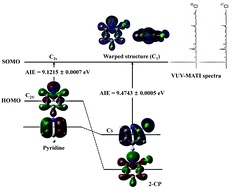Determination of the highest occupied molecular orbital and cationic structure of 2-chloropyridine by one-photon VUV-MATI spectroscopy and Franck–Condon fitting
Abstract
2-Chloropyridine (2-CP) has received significant attention, owing to the effect of the substitution of a halogen in pyridine on the highest occupied molecular orbital (HOMO). To elucidate the substitution effect of the chlorine atom on the HOMO of pyridine, we obtained one-photon vacuum ultraviolet mass-analysed threshold ionization (VUV-MATI) spectra of 2-CP having 35Cl or 37Cl to analyse the isotope effect on the vibrational mode. Based on the 0–0 band in the MATI spectrum of 2-CP having 35Cl, the adiabatic ionization energy was determined to be 9.4743 ± 0.0005 eV (76 415 ± 4 cm−1) with a similar value for 37Cl, which is much lower but more accurate than the vertical value of 9.63 eV determined by photoelectron spectroscopy. Subsequently, the MATI spectrum, which was affected by the geometrical change with respect to the neutral geometry upon ionization, could be analysed by Franck–Condon fitting and spectral correlation between the two isotopomers. Notably, we observed the appearance of the out-of-plane ring bending modes resulting from ring distortion, unlike in pyridine. Furthermore, natural bond orbital analysis led to the conclusion that the warped structure with C1 symmetry of cationic 2-CP is induced by the electron removal from the HOMO consisting of the π orbital in the pyridine ring, which is stabilized by hyperconjugation with the lone-pair p orbitals of a nitrogen and chlorine atom.



 Please wait while we load your content...
Please wait while we load your content...